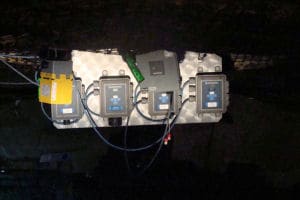Mining Topic: Fire Detection
What is the health and safety problem?
Fires continue to pose an ever-present hazard for U.S. underground coal and metal/nonmetal mines, particularly in conveyor belt entries and other underground locations where significant combustible materials may be stored or used. Fires that go undetected can spread rapidly, increasing in intensity and presenting a severe life threat to underground personnel due to the high levels of smoke and toxic gases produced.
What is the extent of the problem?
While the annual number of mine fires continues to slowly decrease, mine fires remain a significant problem. For instance, for the years 2010 and 2011, there were a total of 91 coal mine fires and 89 metal/nonmetal fires. The main causes of mine fires include flame cutting and welding operations, friction, electrical shorts, mobile equipment malfunctions, and spontaneous combustion. Preventing fires is essential to the health and safety of mine workers.
How is the NIOSH Mining Program addressing this problem?
The NIOSH Mining Program is working to improve the ability to detect and respond to developing fires using a multi-faceted approach that involves atmospheric monitoring of targeted mine locations. This approach seeks to (1) improve the gas and smoke sensors used in an atmospheric monitoring system (AMS) for fire detection and hazard analysis; (2) upgrade mine ventilation algorithms, such as MFIRE 3.0, to include dynamic fire growth, flame spread, and real-time contaminant transport; and (3) incorporate these improved mine ventilation algorithms into targeted mine locations to provide for a dynamic, real-time, and interactive system during actual fire emergencies.
What are the significant findings?
Large-scale fire experiments were conducted in the Experimental Mine at the NIOSH Bruceton Research Facility to evaluate the performances of carbon monoxide (CO) and smoke sensors at low ventilation velocities in a belt entry. A total of eight sensor stations were located downstream of the fire with each station containing CO, smoke, carbon dioxide, oxygen, humidity, barometric pressure, temperature sensors and two airflow sensors. The airflow velocity ranged from 0.22 to 0.26 m/s (44 to 51 fpm) in the tests. Experimental results demonstrate that the low airflow velocity could cause smoke to be unevenly distributed over the mine entry and delay the alarm times for CO and smoke sensors for the small fires. In most of the fire tests, smoke sensors had shorter alarm times than the CO sensors located at the same place. The results indicate that reduced sensor spacing is needed for CO sensors at airflow velocities less than 0.25 m/s (50 fpm). Extrapolation of the test data from a small belt fire implied a minimum sensor spacing of 98.3 m (322.5 ft), while the test data from a large belt fire resulted in a minimum sensor spacing of 165.7 m (543.5 ft), indicating the heat release rate also influenced the sensor spacing. The results of this study can be used to select the proper type of fire sensors and determine the appropriate sensor spacing when ventilation velocities less than 0.25 m/s (50 fpm) are used in the belt entry.
The NIOSH Fire Prevention Team developed a new methodology to integrate real-time AMS monitoring with the mine fire simulation program, MFIRE 3.0, to conduct real-time mine fire simulations. An AMS data management program was created to link the AMS and MFIRE and process real-time AMS sensor data. Two critical modules embedded in the AMS data management program: Fire Location Module and Heat Release Rate Calculation Module were developed to locate a fire and calculate the real-time fire size using AMS monitoring data. This data on fire location and intensity was then fed to MFIRE for real-time fire simulation. With the real-time data from the AMS, the MFIRE program can determine the smoke and toxic gas spread in the entire ventilation network accurately on a real-time basis. This integrated real-time mine fire simulation system was validated using experimental data collected from large-scale fire tests conducted at NIOSH Safety Research Coal Mine and can help mine operators and safety personnel make informed decisions on fire-fighting strategies and underground personnel evacuation and escape in the event of a mine fire.
What are the next steps?
No future work in this area is planned at NIOSH now.
- Analyses of Mobile Equipment Fires for All U.S. Surface and Underground Coal and Metal/Nonmetal Mining Categories, 1990-1999
- Analysis of Mine Fires for All U.S. Metal/Nonmetal Mining Categories, 1990-2001
- Analysis of Mine Fires for All U.S. Underground and Surface Coal Mining Categories: 1990-1999
- CFD Modeling of Fire Spread Along Combustibles in a Mine Entry
- Evaluation of Smoke Detectors for Use in Underground Mines
- Fire Response Preparedness for Underground Mines
- Impact of Air Velocity on the Detection of Fires in Conveyor Belt Haulageways
- In-Mine Evaluation of Smart Mine Fire Sensor
- Innovative Strategies for Mine Fire Preparedness
- MFIRE - 4.0.2.0
- Mine Fire Detection in the Presence of Diesel Emissions
- Mine Fire Detection in the Presence of Diesel Emissions
- Mine Fire Diagnostics Applied to the Carbondale, PA Mine Fire Site
- NIOSH Mine Fire Research in the United States
- Overview of Mine Fire Detection
- Responders to Underground Mine Fires
- The Status of Mine Fire Research in the United States
- A Summary of U.S. Mine Fire Research
- Technology News 549 - MFIRE 3.0 - NIOSH Brings MFIRE into 21st Century
- Understanding Mine Fire Disasters by Determining the Characteristics of Deep-Seated Fires
- The Use of Light Scattering and Ion Chamber Responses for the Detection of Fires in Diesel Contaminated Atmospheres
